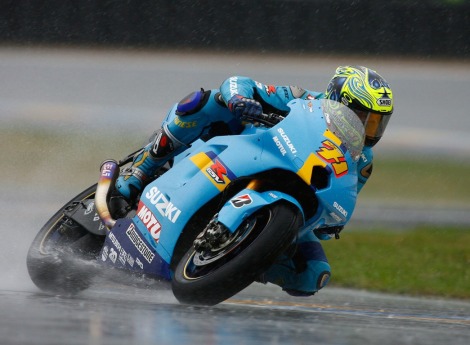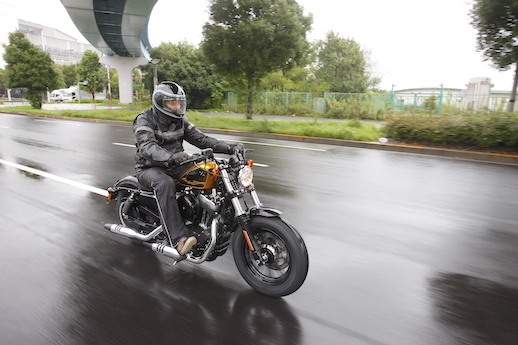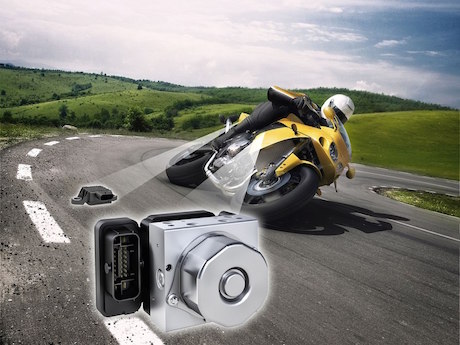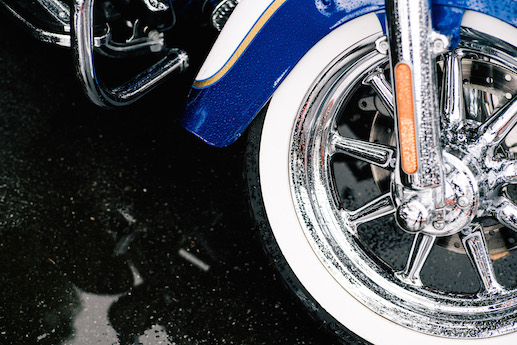Next time it’s raining and the roads are wet, don’t stay inside watching the TV, get out and ride safely using our expert riding tips. It’s good practice.
Rather than give you our tips for riding on wet roads, we assembled a panel of experts to get their tips on riding techniques, tyre choice, roadcraft, rider and bike set-ups and the latest electronic wizardry to help us tackle slick roads.
Among them is 2003 World Supersport champion, 10-time World Superbike race winner and MotoGP winner Chris Vermeulen for some expert advice. Chris won the 2007 Le Mans GP in the rain, so he knows what he’s talking about.
He says you never can tell when you will get caught in the rain and it’s best to have some practise in the wet.

We also spoke with Mark Jackman of Bosch Australia who make ABS and traction control systems; Pirelli Moto technical manager and historic road racer Leo Cash; Craig McMartin a long-time racer who has won nine national road racing titles and is technical advisor at Ducati; Stay Upright instructor development manager Wayne Clarke; Murray Sayle of Kawasaki which has a host of road models with ABS standard; and Miles Davis marketing manager of BMW Motorrad Australia and a proponent of electronic rider aids. He says riding in the rain can give you extra confidence in the dry.
Our experts have already given us their tips about setting up your bike, body and mind for riding in the wet. You can read their tips here.
Now we tackle the art of how to ride safely on a wet surface.
While they don’t all agree on every facet, there are a few things they do agree on, mainly the need for riders to be smooth.
ROADCRAFT
There was a lot of disagreement here. Even the racers disagreed about the best lines on a wet racing circuit. Most suggested that you take a longer arc through a corner so you don’t need to lean the bike over as far.
However, Chris has a totally different approach to riding safely on a wet race track: “You need to keep the bike straight for as long as possible and spend as little time on the edge of the tyre. That means different lines to riding in the dry. You don’t arc through the corner as much; you want to stop and start the motorcycle more in the rain and keep the corners shorter.”
But tracks are smooth and consistent. Public roads can have oil between the tyre tracks, gravel and mud washed on to the surface, leaf litter and moss on the edges and Murray also pointed out that water can pool on the outer edges of the roads because of the damage from heavy vehicles.
Some of our experts suggest you are still better to arc the corner even on public roads.
Miles talks about “optimising your lines” to create the smoothest corners: “Sharp, sudden movements will compromise traction. A flowing line usingas much of the lane as you can will provide a better result.”
Others suggested you follow the wheel tracks around the corner as cars will have cleaned this surface of standing water and any debris or oil spills.

Some say your technique might vary in the city where there is more likely to be oil spills between the lines than in the country where the roads tend to be cleaner. However, we’ve found many a country road where trucks have left oil spills.
Cities also throw up dangers such as white paint on the road, metal manhole covers and, in Melbourne, treacherously slippery tram tracks.
Chris suggests entering corners slower than you expect you need to, so you have plenty of time to assess the situation: “You can always accelerate harder out of the corner to make up time. I try not to use the full amount of the road because you are going into somewhere that’s blind and if the bike does slide, it’s good to be able to react or run wider or turn tighter to change your line.”
Wayne sums it up best: “Take each corner on its merits.”
All agree that to pull up safely at traffic lights, you should position your bike in the tyre tracks to avoid not only oil spills, but also diesel and radiator overflow which includes slippery coolant.
Another point in roadcraft is to telegraph your intentions early to following traffic by using your brakes rather than engine braking so that the rear brake light activates.
RIDING TECHNIQUE
When asked for their top tip for riding safely in the wet, our experts all use the word “smooth”.
“There is obviously less grip and the bike is less forgiving so you have to be smooth on all your inputs into the bike such as throttle, brake, clutch and moving your body weight. Every action you do on the bike upsets it more,” says Chris.
Obviously throttle application and clutch action needs to be smooth and progressive to prevent the rear wheel from spinning. Riders should also practise short-shifting or changing up to the next gear earlier than they would in the dry. Murray Sayle of Kawasaki says this means riders are using the torque of the engine rather than the peak power.
When changing down gears, riders should try to match the engine speed with the road speed and let the clutch out safely and slowly so the rear wheel doesn’t lock under engine compression.
Wayne agrees that throttle and clutch actions should be smooth, but puts more emphasis on the use of brakes in the wet.
“If I need to drop the throttle – say, if I’ve gone into a turn too hot – you get too much weight shift, so I like to add a little bit of pressure to the rear brake instead. It dips the front slightly which helps it to turn a bit more. I use rear brake in most corners and use a lot of rear brake for doubling and in the wet.”
Chris has been known to use the rear brake even under heavy acceleration to stop it from spinning. He also advises that you can use maximum pressure on the brakes in the wet, so long as you apply them smoothly and progressively. “But you have to load the brakes while the bike is still upright,” he says.

Which brings us to the interesting point of leaning the bike safely in the wet. Leaning a bike increases the sideways G forces on the tyre which can cause it to slide on low-friction wet surfaces. So how do you turn corners without leaning the bike?
“The way to make a bike turn while upright is to get your arse off the seat further,” says Chris. “You might look silly because you are a long way from getting your knee down, but the wind resistance in higher speed corners actually slows you down and makes the bike turn slightly.”
There was some resistance to getting too far out of the saddle, though.
Wayne says some rides over-exaggerate it: “If you are pushing your body out too far you don’t feel like you are part of the bike. The further you push your body out of the seat the more you lose feel of where the tyres are on the road, particularly the front. I mainly lean my upper body, but not excessively. You want to be part of the bike.”
Chris says riders need to safely and smoothly move their bodies off the bike as much as possible to keep the bike upright.
“When we’re racing on top quality tyres you can still get your knee on the ground in the wet as a feeler and a gauge, and as a third wheel. It gives you confidence if you can feel the condition of the ground through your knee. Also, if the tyre slides a little you can save it with your knee. If I’m riding a street bike, I still like to get the weight off the side of the bike as it helps it turn.”
Craig says riders have to be careful about how far they lean off the bike when they are changing from a left to a right turn: “You can’t pick up and throw the bike to the opposite side as quickly as you can in the dry,” he warns. “I hang off the bike a bit more in the wet and hold the bike a bit more upright. You also lift it up to the fatter part of the tyre a lot quicker when exiting a corner.”
ELECTRONIC RIDER AIDS
Even though Kawasaki has a lot of bikes with ABS as standard, Murray admits that the braking distance will be increased due the lower traction of the wet road.
But does that mean you shouldn’t use it?
Chris says he doesn’t use ABS on the track but Craig does.
“I use it in the wet. ABS is really good at Eastern Creek. I rode a stock bike and had the ABS on level 1 which is the front wheel only and it was absolutely perfect.”
There is more agreement on traction control among road riders and racers.
Chris had traction control throughout his GP career: “When I first went out on a wet track, I would wick it up and gradually turn it down as you get more feel for the grip levels. I would basically use the traction control to understand where the grip is. I wouldn’t do that on the road.

“Traction control, like ABS, is a great safety barrier. It lets you make a mistake without crashing. If it’s cutting in all the time you haven’t learnt where the grip is. But you never can fully know grip levels on the road, like you can on a racetrack. We go round lap after lap on the same circuit and there are track marshals there to warn us if there is an oil spill. We know what is in front of us. On the road, you have no idea what dangers lie ahead.”
Craig likes to vary his Ducati’s eight-level traction controls according to track conditions. “I turn the traction control up to 4-5 depending on how wet it is and leave it on 2 in the dry,” he says.
Miles says riders with bikes with ABS and traction should still ride as if they don’t have ABS. “They are a big fat safety net. There is no substitute for good riding technique and control use but even so the safety net lets you enjoy your riding knowing that if you misjudge something the bike will tell you that you had a potential lock-up when you get a ABS pulse or loss of engine induction.
“You’ll hear some riders say you rely on it and become a bad rider. I think it’s like an aid that will take an average rider and give them an insight into traction levels without learning by crashing.
“If you put a kid on training wheels first they get a feel for it and then you can take the wheels off. ABS and ATC are like that.”
Craig is a devout electronic aids rider, fiddling with the ABS, traction and suspension controls. He also likes electronic engine brakes and a slipper clutch which automatically matches engine and road speeds to prevent rear wheel compression lock-up.
“I never had it on the 1198 and you had to be really careful on the clutch in the wet, but on this (Panigale) you just release it. The electronic engine brake also holds the revs up going into a corner. There are three levels from no engine brake like a two-stroke to normal four stroke.”
Now go out and practise riding safely in the wet every chance you get!



